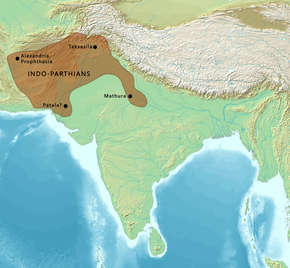
Back هیند-پارتیلر شاهلیغی AZB Индо-партско царство Bulgarian Regne Indo-Part Catalan Indoparthské království Czech Indo-Parthisches Königreich German Hindio-Partia Reĝlando Esperanto Reino indo-parto Spanish Indo-Partiar Erresuma Basque پادشاهی هندوپارتی Persian Indoparthialainen kuningaskunta Finnish
Indo-Parthian kingdom | |||||||||||||||||||
|---|---|---|---|---|---|---|---|---|---|---|---|---|---|---|---|---|---|---|---|
| 19 CE–226 CE | |||||||||||||||||||
Indo-Parthian kingdom at its maximum extent, circa 40 CE, and neighbouring South Asian polities.[1] | |||||||||||||||||||
| Capital | Taxila Kabul | ||||||||||||||||||
| Common languages | Aramaic Greek Pali (Kharoshthi script) Sanskrit, Prakrit (Brahmi script), Parthian | ||||||||||||||||||
| Religion | Buddhism Hinduism Zoroastrianism | ||||||||||||||||||
| Government | Monarchy | ||||||||||||||||||
| King | |||||||||||||||||||
• 19–46 | Gondophares I (first) | ||||||||||||||||||
• ?–226 | Farn-Sasan (last) | ||||||||||||||||||
| Historical era | Antiquity | ||||||||||||||||||
| 19 CE | |||||||||||||||||||
• Disestablished | 226 CE | ||||||||||||||||||
| |||||||||||||||||||
The Indo-Parthian kingdom was a Parthian kingdom founded by Gondophares, and active from 19 CE to c. 226 CE. At their zenith, they ruled an area covering parts of eastern Iran, various parts of Afghanistan and the northwest regions of the Indian subcontinent (most of modern Pakistan and parts of northwestern India). The rulers may have been members of the House of Suren, and the kingdom has even been called the "Suren Kingdom" by some authors.[2]
The kingdom was founded in 19/20 when the governor of Drangiana (Sakastan) Gondophares[3] declared independence from the Parthian Empire. He would later make expeditions to the east, conquering territory from the Indo-Scythians and Indo-Greeks, thus transforming his kingdom into an empire.[a][5] The domains of the Indo-Parthians were greatly reduced following the invasions of the Kushans in the second half of the 1st. century. They managed to retain control of Sakastan, until its conquest by the Sasanian Empire in c. 224/5.[6] In Baluchistan, the Paratarajas, a local Indo-Parthian dynasty, fell into the orbit of the Sasanian Empire circa 262 CE.[7]
The Indo-Parthians are noted for the construction of the Buddhist monastery Takht-i-Bahi (UNESCO World Heritage Site) in Mardan, Pakistan.
- ^ Schwartzberg, Joseph E. (1978). A Historical atlas of South Asia. Chicago: University of Chicago Press. pp. 21, 145, map XIV.1 (f). ISBN 0226742210.
- ^ Gazerani 2015, p. 26.
- ^ Ghosh, Suchandra (2016-01-11), "Indo-Parthian Kingdom", in Dalziel, Nigel; MacKenzie, John M (eds.), The Encyclopedia of Empire, Oxford, UK: John Wiley & Sons, Ltd, pp. 1–2, doi:10.1002/9781118455074.wbeoe038, ISBN 978-1-118-45507-4, retrieved 2023-01-28
- ^ Ellerbrock 2021, p. 117.
- ^ Rezakhani 2017, p. 35.
- ^ Olbrycht 2016, p. 25.
- ^ "New light on the Paratarajas" Pankaj Tandon p.29-35
Cite error: There are <ref group=lower-alpha> tags or {{efn}} templates on this page, but the references will not show without a {{reflist|group=lower-alpha}} template or {{notelist}} template (see the help page).

